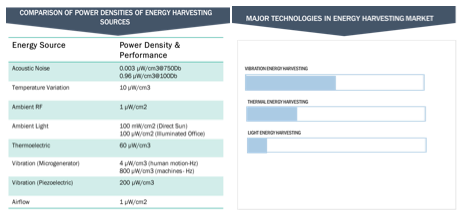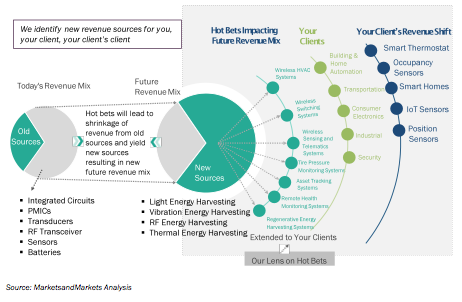Energy harvesting systems capture ambient energy from the environment and convert it into electrical power for low-power electronic devices. They extract energy from sources like light, heat, vibration, motion, radio waves, or electromagnetic fields using specialized transducers. This harvested energy can power devices immediately or be stored in batteries for later use.
These systems provide a sustainable, self-sufficient power solution, reducing reliance on traditional sources for applications such as wireless sensors, IoT devices, wearables, and remote monitoring.
The global energy harvesting system market is projected to grow from USD 570 million in 2023 to USD 918 million by 2028, registering a CAGR of 10.0%. The energy harvesting system market is driven by the rising demand for clean and sustainable energy solutions. The increasing use of IoT devices and wireless sensor networks also requires self-sustaining power sources for remote and challenging locations. These factors are expected to propel the growth of the energy harvesting system market in the coming years.
END USE SYSTEMS IN THE ENERGY HARVESTING SYSTEM MARKET
End-use systems in energy harvesting enable the efficient conversion of ambient energy into power for various applications. These systems can power wearable devices, IoT sensors, and remote monitoring systems, reducing reliance on traditional batteries.
Wireless Switching Systems
Wireless switches utilize energy harvesting principles to convert mechanical energy from actuation into electrical energy. This electrical energy serves as a secondary power source for mechanical actuators, emergency switches, and as a controller for starting and stopping machines. The use of wireless switching is ideal in situations where wiring is impractical, or the cost of wired sensor networks is high. In wired sensor networks, the cost of batteries and wiring comprises a significant portion of the overall expenses. Energy harvesting addresses this issue by serving as a primary energy source, collected from sources like light, vibration, or heat. In cases where high power is needed, the harvested energy can be stored in a secondary battery, which can then power wireless sensor devices. This approach reduces costs, minimizes maintenance needs, and boosts system uptime.
Wireless HVAC Systems
Building automation systems in commercial, residential, and institutional facilities utilize sensors powered by energy harvesting systems to monitor ambient parameters, optimizing energy consumption. Piezoelectric and thermal energy harvesters within heating, ventilation, and air conditioning (HVAC) systems leverage airflow effects for energy production. Wireless HVAC systems, revolutionizing building control, integrate energy harvesting technologies like solar panels and thermoelectric generators into components such as sensors and actuators. These devices operate autonomously, monitoring temperature, humidity, and occupancy while controlling valves and fans for sustainable, real-time system optimization. The integration of energy harvesting addresses sustainability concerns, driving the adoption of wireless HVAC systems in retrofitting and areas with challenging power connections, offering precise control for optimal energy efficiency and improved comfort
Wireless Sensing & Telematics Systems
Wireless sensing leverages sensor networks connected through wireless protocols for remote monitoring of environmental conditions like temperature, pressure, and air quality across various sectors including military, aerospace, and transportation. Energy harvesting systems facilitates the operation of such systems by converting ambient sources like heat, light, and motion into electricity. In automotive applications, energy harvesting systems powers hardware of telematics systems, supplying sensors and controllers with energy harvested from vehicle motion, engine heat, and suspension pressure. Similarly, in smart homes and building automation, energy harvesting systems enables sensor devices to monitor and control systems, facilitating functions such as lighting, cooling, and security, enhancing overall efficiency and sustainability.
Asset Tracking Systems
Asset tracking involves monitoring physical assets by scanning barcodes via RFID or GPS tags. RF sensors and tags have diverse applications, from inventory and fleet management to equipment tracking in hospitals and retail. They're also used in monitoring structures like bridges for maintenance needs. However, traditional RFID tags rely on batteries with limited lifespans, resulting in high replacement costs. Energy harvesting, including light and vibration technologies, offers sustainable alternatives, favoured for their higher power densities. These technologies, alongside ambient radiation, temperature gradients, light, kinetics, motion, and vibrations, offer renewable energy sources for active RFID tags, promising extended operational lifespans and decreased maintenance expenditures.
Here is a concise explanation of how changes in revenue sources can affect the energy harvesting system ecosystem.
Market estimation of energy harvesting system
The energy harvesting system market for light energy harvesting is expected to register the highest CAGR and market share during the forecast period. Governments globally are enacting policies and offering incentives to boost the adoption of renewable energy, particularly light energy harvesting technologies. For example, the US government provides a federal Investment Tax Credit (ITC) for solar energy systems, encouraging the use of photovoltaic cells. Similarly, Germany's feed-in tariff system guarantees payments for renewable electricity, driving the installation of solar panels and fostering the light energy harvesting sector's expansion. These measures, along with tax credits and feed-in tariffs, encourage investment and innovation, propelling the growth of the light energy harvesting market in the forecast period.
By Application, The building & home automation sector held the largest share in 2023, driven by the growing demand for energy-efficient and smart living environments. The integration of energy harvesting systems into these applications is a significant growth factor, providing sustainability, convenience, and cost savings. These systems improve energy efficiency by utilizing renewable sources like solar, thermal, or kinetic energy to power lighting, HVAC systems, sensors, and smart devices. With wireless connectivity and scalability, these systems offer easy integration without complex wiring. Additionally, the maintenance-free operation and reduced environmental impact of energy harvesting systems further contribute to their growth in building & home automation applications.
During the forecast period, North America is anticipated to dominate the energy harvesting system market, driven by a growing focus on renewable energy and sustainability. Governments and regulatory bodies are implementing policies and incentives to encourage the adoption of clean energy solutions, boosting the demand for energy harvesting systems. For instance, in April 2023, the Biden-Harris Administration announced an investment of USD 82 million to bolster domestic solar manufacturing and recycling, enhancing the American clean energy grid. This initiative includes nineteen projects across twelve states in the US to establish a domestic solar supply chain. Furthermore, the increasing prevalence of the Internet of Things (IoT) and wireless sensor networks in North America is expected to further propel the growth of the energy harvesting systems market in the upcoming years.
Key companies operating in the energy harvesting system market are STMicroelectronics (Switzerland), Microchip Technology Inc. (US), Texas Instruments Incorporated (US), Analog Devices, Inc. (US), Infineon Technologies AG (Germany), Renesas Electronics Corporation (Japan), EnOcean GmbH (Germany), ABB (Switzerland), Honeywell International Inc. (US), Qorvo, Inc. (US). Following are some of the key developments in the recent years-
• In June 2023, ABB acquired Eve Systems (Germany), a smart home products manufacturer, to strengthen its smart home technology portfolio.
• In March 2023, STMicroelectronics launched new STM32 microprocessors that enable lower operating costs and improved safety. They have applications in industrial automation, communication gateways, payment terminals, appliances, and control panels.
• In March 2023, Infineon Technologies AG launched the NGC1081, a new NFC tag-side controller that integrates sensing and energy harvesting capabilities.
FUTURE OUTLOOK
The energy harvesting sector is set for expansion due to technological progress, rising demand for sustainable energy, and favorable regulations. These systems utilize ambient energy sources for power generation, promising a greener future. With continuous innovation and market support, they are poised to make a significant impact on renewable energy and sustainability.
www.marketsandmarkets.com






















































































